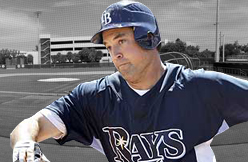ST. PETERSBURG — The question is not about what went wrong, which was pretty much everything between coming and going.
The question is not about the size of the contract, although you can sum up Pat Burrell's Rays' Daze this way: The guy got a million dollars for each of his 16 home runs, which is far too much money for far too little muscle.
The question is not about the measure of the mistake of signing him, which was bad enough to apply for federal funding. To sum it up, signing Burrell was the worst idea in Rays franchise history. Worse than Wilson Alvarez. Worse than Vinny Castilla. Worse than Ben Grieve.
No, in the mercifully brief, thankfully complete term of Burrell, only one question counts:
Gee, Andrew, what took you so long?
It is over now, the unpleasant, unproductive stay of Burrell. It is only the middle of May, but executive vice president of baseball operations Andrew Friedman and the rest of the Rays' front office finally have seen enough. Burrell has gone from being a designated hitter to being designated for assignment, which is a polite way for a team to inform a player that it is willing to pay him millions of dollars to stay away.
Why? Because in the case of Burrell, it's worth it.
What a sad swing-and-a-miss he turned out to be. He couldn't throw, couldn't field, couldn't run and, from all indications, couldn't smile. In Tampa Bay, he was never "Pat the Bat." In Tampa Bay, he was "Pat Can't Hit That."
Now here's a sobering thought. If Burrell hadn't been shown the door Saturday morning, manager Joe Maddon said it would have been him — not Willy Aybar — at the plate in the bottom of the ninth against the Mariners with the score tied. Anyone think Burrell would have hit a walkoff homer?
In the end, do you know what Burrell's legacy will be? Because of him, Hank Blalock is about to become the most popular DH in Rays history. Why? Because he isn't Burrell. And that's a start.
That's the thing about Tampa Bay fans. They don't warm easily to a nonproductive mercenary. In his brief stay, Burrell was right there with the least popular of Rays — Alvarez, Castilla, Grieve. And remember, this is a franchise that flirted with John Rocker and Roberto Alomar, too. You could argue that few athletes in Tampa Bay history — maybe Michael Clayton, maybe Jerramy Stevens, maybe John Grahame, maybe Trent Dilfer, maybe Castilla or Alvarez — have been this unpopular.
I don't know about you, but I think we should give Burrell the key to the city. Provided, of course, that city is Philadelphia.
Let's be honest. Burrell isn't the only guy in the batting order who was struggling. At times, these guys make you wonder if there are termites in the batting cage. There are hitters who might as well bring a golf club to the plate and try to hit sliders with that. Clearly, it was time to get some help from somewhere.
Enter Blalock, who was signed in spring training because the Rays figured a day such as Saturday might be coming. After watching Burrell's struggles most of last season, the Rays were aware this year might not go the distance.
Will Blalock be any better?
How on earth could he be any worse?
So where did it go wrong for Burrell? In January 2009, he looked like such a good signing that even Blalock's agent, Scott Boras, was arguing that the Rays got off cheap. Odd. Boras hasn't made that argument lately.
Even then, Burrell had his flaws. On a team built on speed and defense, he possessed neither. But for most of his years, Burrell had been a solid hitter with predictable results. For four straight seasons, he had averaged 30 homers and 90-something RBIs. The Rays saw him as an equalizer against left-handed pitching. The fans saw him as a signpost of how hungry owner Stu Sternberg was to get back to the playoffs.
So how could Burrell fail so miserably? Maybe part of it had to do with adjusting to the American League. Maybe part of it had to do with adjusting to being a designated hitter. Maybe part of it had to do with adjusting to being a 33-year-old hitter.
Regardless, he was never an impact player with the Rays. They might as well have sent an ATM to the plate four times a night. It would hit as much and run as fast, and no one would have had to stuff it with as many dollars.
In the end, he was Pat the Pact. That's a truth about sports. No one seems to mind how much the great players make. The failures? Fans can recite those to the dime.
What did the Rays get for their $16 million? Burrell played in 146 games, so you can think of it as $109,583.04 per game. He hit .218, so you could think of it as $174,824.18 per hit. He drove in 77 runs ($207,792.20 per RBI). He had 496 plate appearances, so you can think of it as $32,258.06 per trip to the plate. Or, if you prefer, you can remember that Burrell's 147 strikeouts earned him a total of $4,741,934.82.
That's a lot of money. Sadly, it didn't buy a lot of memories.

(tampabay.com)



